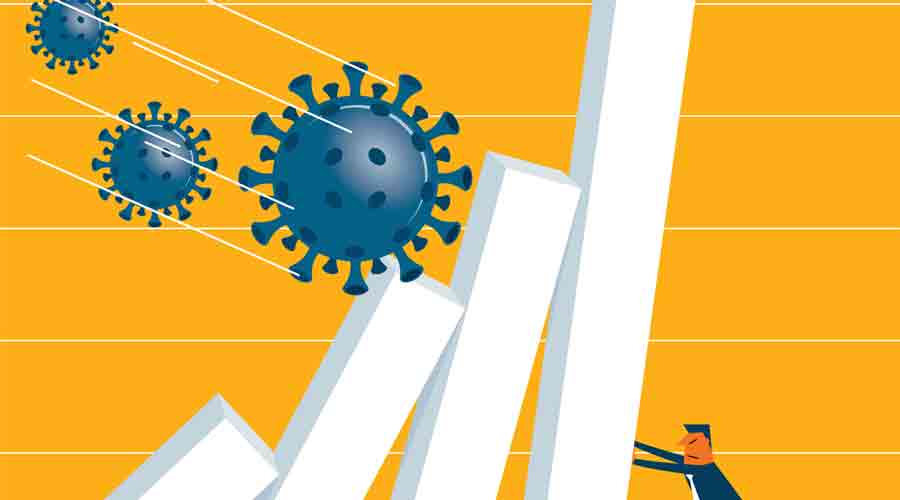The third year of the coronavirus pandemic, 2022, starts on an odd note. Omicron, the contagious mutation, is storming the world, upending recoveries and economic prospects. Yet, economic policies are decoupled from the pandemic. Such a delinking was unimaginable even six months ago. But the imbalances triggered by the pandemic can no longer be ignored. Inflation has fast displaced the virus as a bigger risk to growth. This is especially true for the United States of America, where its sprint and characteristics justify monetary action. Even though the pandemic is far from over, 2022 is globally set to be a year of macroeconomic transitions — from the exceptional, sole devotion of policies to pandemic redressal towards normality, repair and rectifying imbalances.
Transitions are risky. They are riskier when changes happen amidst a persistent pandemic with an uncertain course. The growth outlook is thus at risk from changeovers to less-easy monetary and consolidative fiscal policies, the continuing pandemic and its fallouts, rising prices or inflation.
In the US, which matters most to the world economy by the kind of monetary policy it runs, inflation has overtaken and replaced all else for policy attention. So tenacious has been the grip and forceful the growth in consumer prices that they have upset all calculations, compelling its central bank, the US Federal Reserve, to recognize that the price pressures will not simply pass over as anticipated some time back. Inflation requires demonstrated action to prevent a self-perpetuating spiral formation even if growth is imperilled and there is concern that the economy tipping into recession. About three to four interest rate increases are expected from the US Fed this year. Major central banks are also scaling back asset purchases, pushing up sovereign bond yields.
Global interest rates and liquidity conditions, investor-risk perceptions and portfolios are poised for sea change with an unexpected time path this year. These translate into higher financial market volatility through interconnectedness, sudden changes in and scarcer foreign capital inflows, and the repricing of assets. Emerging market economies, including India, are always at more severe risk because of shallower markets, external capital dependencies, and vulnerabilities to global price shifts, including oil and commodities. We can already observe transmission of higher global yields upon India’s benchmark sovereign debt, where costs have risen. Besides interest rates and volatility, tightening financial conditions abroad would also bind domestic policies to be fool-proof against possible, destabilizing external shocks or against a rise in external constraints upon monetary and fiscal this year.
The other risk from the US monetary tightening is of slowing world growth that will, no doubt, drag down trade volumes too. In 2021, external demand — a mix of repression and enrichment from fiscal relief given by advanced countries — fired export growth across emerging economies and in India. In 2022, normalizing demand in advanced countries, the not-so-insignificant risk of hard landing in the US as monetary policy catches up, and a slowing China, which is struggling to return to its pre-pandemic growth rate, threaten exports.
India has also been facing persistent, elevated inflation for over a year, although not of the magnitude or from excess demand as contributor like that in the US. Yet, even if due to supply pressures, rising prices of food, energy, other products and services can eat into the real spending power of consumers. Real personal consumption expenditure is 95% of what it was in 2019-20 by the first advance national accounts published on January 7. Personal disposable income growth has been static in the two years to March 2022. This reflects the pressure of demand contraction. Inflation can cripple this even more; it is inimical to recovering consumption when the need is to get this going and spur business spending in the next leg for a self-sustaining foothold. The Reserve Bank of India expects inflation to abate from mid-2022 onwards but absolute costs will remain high. The dampening risk to consumer demand is pitted against raising interest rates or the price of money, which, too, will dent borrowing or loan demand that is none too encouraging. Such conflicts are hard to resolve even in ordinary settings. They are tougher to manoeuvre around when external conditions become less-friendly, infections are at-large, and the growth upswing is neither strong nor durable.
The first assessment of real GDP growth in 2021-22 is 9.2%. This is distorted by last year’s historic collapse to -7.3% and represents a feeble 1.3% lift from the 2019-20 GDP. Aggregate consumption is 97% of the then level while production segments, such as construction, transport, retail, hospitality and so on that engage a large volume of workers in low-paid tasks, are under pressure and distant from where they were two years ago. The silver lining — robust growth of exports — is a timely impetus when India faces deficient domestic demand from weakened consumption and investments while the government has little spending fuel to fire the economic engine. These early estimates are likely to be scaled down owing to Omicron’s damages in this quarter; many have lowered them by 20-60 basis points already.
At the start of 2022, the durability of recovery and the true strength of the economy elude precise assessment. This is because of the bunching of pent-up and revenge-cum-festival spending, which makes it very difficult to distinguish it from regular demand; external demand is subject to similar distortions and misreading. There are signs of fallback in industrial output, purchasing manager indices and so on; the post-second wave sales volumes failed to meet expectations in the last quarter. Overall, more proof of sustenance, including that of exports, is needed.
Consensus growth forecasts for next year, 2022-23, are in the 7-7.5% region. The expectant drivers are public capex, the production-linked incentive scheme, gains from structural reforms and anticipated pick-up in private investment. It needs to be borne in mind that other than the risks mentioned afore, demand could be impacted by widened poor-rich divergence that is amply visible. For example, the plunge in two-wheeler sales to 2012 numbers against robust growth of cars with the highest-ever growth of luxury ones, reduced earning members per household captured by CMIE’s survey, and the recent Oxfam report showing that the income of 84% of Indian households declined in 2021 while the number of Indian billionaires grew from 102 to 142. Growth will remain under the pressures of transitioning policies, the ongoing pandemic, demand weaknesses and inflation. The good thing is there is pervasive optimism, a positive start to a new year.
(Renu Kohli is a macroeconomist)










